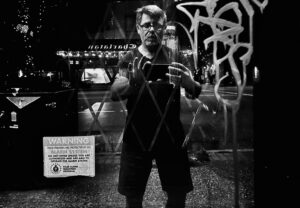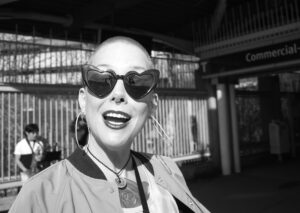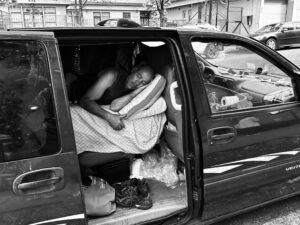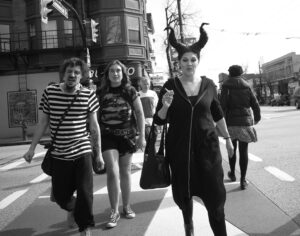The street’s music
A new street photographer takes up a challenge that has captivated other Vancouverites for decades.
August 13th, 2025

Rodney DeCroo captures the grit, eccentricity and quiet beauty of East Vancouver
“DeCroo’s photos have spotlit a Vancouver that’s about something more than unlimited growth and runaway commerce.”—Mike Usinger, Georgia Straight senior editor who wrote the foreword to Night Moves.
Review by Beverly Cramp
East Vancouver, even with its sprinkling of middle-class bohemians and professionals, puts the lie to Vancouver’s Lotusland nickname—as Rodney DeCroo shows in his debut book of street photography, Night Moves.
“DeCroo’s photos have spotlit a Vancouver that’s about something more than unlimited growth and runaway commerce,” writes Mike Usinger in the book’s foreword, adding “a place where not everyone dreams of owning a Tesla or a three-bedroom condo, mostly because in all likelihood that’s not going to happen.”
Known for his poetry, singing and songwriting, and playwriting, DeCroo has been shooting street life, what he refers to as “street music,” for the past half-decade. His pictures, like most artistic endeavours that DeCroo pursues, are “defiantly DIY,” says Usinger. “Untrained, he simply picked up a cheap digital camera and started shooting. And while he’ll argue today that it took him a while to figure things out, even his earliest works make a case that he hit the ground running.”
DeCroo’s street shots were quickly noticed by other publishers. Years before the release of this slender volume, his photos appeared in the glossy Montecristo magazine as well as subTerrain and The BC Review, proof that his new work earned early recognition.
 De Croo sporadically includes poetry in Night Moves, such as “New Camera,” in which he tells of buying a camera despite his fears of disappointing results. “Failure would be the rule, / the beautiful exceptions few,” he writes. He fretted about being able to capture the magic of the street and people getting angry at him for taking their picture without permission. Yet on the way home with his new gadget, DeCroo says that he pointed “the camera at the windshield / as the sun appeared between the clouds / and for a moment everything was light.”
De Croo sporadically includes poetry in Night Moves, such as “New Camera,” in which he tells of buying a camera despite his fears of disappointing results. “Failure would be the rule, / the beautiful exceptions few,” he writes. He fretted about being able to capture the magic of the street and people getting angry at him for taking their picture without permission. Yet on the way home with his new gadget, DeCroo says that he pointed “the camera at the windshield / as the sun appeared between the clouds / and for a moment everything was light.”
And so DeCroo joins the ranks of other street photographers in Vancouver like the late Fred Herzog (1930 – 2019), who worked mostly with colour slide film, raising his images to high art with his understanding of the technical medium and, as Herzog said, “how you see and how you think.” Like DeCroo, Herzog also chose the grittier streets of Vancouver, although he started much earlier in the 1950s and carried on until the 2010s. Herzog’s colour slides were later developed into large-format prints, framed and sold at commercial galleries for high prices.
DeCroo’s path to startling pictures didn’t come easy, says Usinger. “The reality… is that street photography is also about endless intangibles: timing, intuition, reflexes, curiosity, empathy, and ultimately an understanding that every one of us on this planet has a story to tell, even if we don’t always recognize that,” he writes. “Part of the power of [DeCroo’s] work is a recognition that not all of those stories are happy ones.”
That may have been an understatement. DeCroo shows us tired grimaces; angry, explosive looks and hands raised as if about to reach out to throttle someone or something; annoyed faces turning away; lonely nighttime scenes at bus shelters; a guardian shielding a small girl from Downtown Eastside denizens at the side of a busy street. We see a man carrying his belongings in a single plastic bag thrown over a shoulder; another man asleep in the back of a van that looks for all the world like a temporary home; young couples clutching hands.
DeCroo is drawn to the poor and working class, perhaps reflecting his own upbringing in a coal-mining town just outside Pittsburgh, Pennsylvania, where he was exposed to fighting, underage drinking, abuse and neglect. He later moved to BC and eventually settled in East Vancouver, where he has lived for over three decades.
 But DeCroo also celebrates eccentrics: a woman with a wide-mouthed smile peering out of heart-shaped sunglasses; people on the street proudly sporting wild hairstyles and leather jackets with inch-long spikes (showing their right to “fly one’s freak flag,” says Usinger); a small boy greedily licking an ice cream cone; a coffee drinker staring dreamily out of the Continental Café; a woman carrying her cat on her shoulder as it digs its claws into her for balance.
But DeCroo also celebrates eccentrics: a woman with a wide-mouthed smile peering out of heart-shaped sunglasses; people on the street proudly sporting wild hairstyles and leather jackets with inch-long spikes (showing their right to “fly one’s freak flag,” says Usinger); a small boy greedily licking an ice cream cone; a coffee drinker staring dreamily out of the Continental Café; a woman carrying her cat on her shoulder as it digs its claws into her for balance.
There are several night scenes in this book, as the title Night Moves suggests. DeCroo suffers insomnia and finds solace on the darkened streets, which has led him to produce sublime images of East Vancouver, like his nighttime shot of the Fox Cabaret sign on Main Street, garlanded with tree leaves glistening under a street lamp.
DeCroo has discovered that photographing photos of people on the street is not a proverbial walk in the park. In one instance, after someone called him “a creep” for taking photos of strangers—telling him it’s “offensive” and possibly “perverted”—he took it to heart. DeCroo’s response came in the form of a poem, “An Older Dishevelled Man” and reveals part of his rationale for continuing: “… maybe she’s right, but I can’t / shake the idea that I might find the face / that explains why we’re so alone.”


Leave a Reply